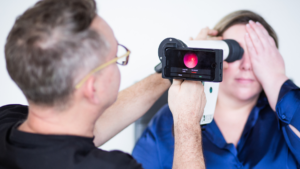Why Diabetic Retinal Exams are Important to Primary Physicians & Other Healthcare Providers

Diabetic retinopathy (DR) is the leading cause of preventable blindness for people aged 20 to 65 in the United States. This condition occurs when high blood sugar damages blood vessels in the retina and restricts blood flow. These blocked blood vessels leak and bleed more easily, potentially leading to vision loss and other problems.
A diabetes eye exam is one of the most effective ways to diagnose and treat DR.
The American Academy of Ophthalmology recommends that all patients with diabetes or pre-diabetes receive an annual retinal eye exam or diabetic eye exam. The Centers for Disease Control and Prevention (CDC) predicts that these routine retinal screenings could help prevent or delay vision loss in 90% of people with diabetes.

This 2022 infographic compares the number of diabetic and prediabetic Americans. Source: Centers for Disease Control and Prevention.
However, a 2023 literature review found that between 23% – 65% of diabetic patients don’t receive annual diabetic eye tests. The people most likely not receiving this vital preventative care include those lacking health insurance, a regular healthcare provider, or a college education. This begs the question: How do we reach the underserved diabetic patient population with preventative measures? The answer starts with primary care physicians (PCPs) and other healthcare providers. When medical professionals outside the ophthalmologist’s office understand the importance of point-of-care diabetic retinal exams, they can help at-risk patient populations.
Find out what healthcare providers can do—and how IRIS can help.
The Importance of Eye Care for Diabetes
The CDC estimates that 38 million Americans have diabetes, which is approximately 1 in 10 people. Another 98 million Americans (1 in 3) have prediabetes. People with prediabetes have elevated blood sugar levels, but they haven’t reached the threshold for a diabetes diagnosis.
Diabetic retinopathy is one of the most common complications associated with diabetes. This condition affects around 33% of people with diabetes to some degree. Additionally, 10% of this population will develop vision-threatening DR during their lifetime.

The infographic compares a normal retina with a retina affected by DR. Source: MedlinePlus.
Diabetic retinopathy is progressive and has two main phases:
- Non-proliferative diabetic retinopathy (NPDR): This preliminary stage begins when high blood sugar causes blood vessels in the retina to leak or close off. Leaking blood vessels causes macular swelling, while blockages prevent blood from reaching the macula. Both types of NPDR lead to blurry vision.
- Proliferative diabetic retinopathy (PDR): This advanced stage occurs when new blood vessels grow in the retina to compensate for the damaged ones. These new vessels are weaker and bleed into the vitreous of the eye. This bleeding can block vision and cause scar tissue.
Blindness caused by diabetic retinopathy is permanent. But the good news is that this vision loss is almost entirely avoidable. An annual diabetes eye exam can detect DR in its early stages. As a result, patients can receive prompt treatment, reducing the risk of permanent effects.

A diabetic retinal exam can also help detect other severe eye conditions. For example, diabetes can cause deposits to build up in the eye’s lens. These deposits form cataracts that cloud vision. People with diabetes are also twice as likely to develop open-angle glaucoma, which causes progressive vision loss. An eye exam lets providers diagnose and treat these conditions early.
Why Should PCPs and Other Healthcare Providers Prioritize Diabetic Eye Exams?
For patients with diabetes, the comprehensive annual dilated eye exam is still considered the gold standard of care. According to the prominent retinal surgeon and IRIS founder Dr. Sunil Gupta, eye care providers can use this exam to diagnose DR and provide cutting-edge treatments:
“Retina specialists now utilize advanced therapies that virtually guarantee that patients do not have to lose their vision if detected early,” said Dr. Gupta. “We have spent over a decade developing effective pharmacological therapies that have changed the realities for diabetic patients with indications of eye disease.”
However, a high percentage of patients with diabetes never get screened or receive an annual diabetic eye test. Primary care providers (PCPs) can bridge this gap by offering preventative screenings well before patients step foot in the ophthalmologist’s office. Here are three reasons to include diabetic retinopathy tests in your practice.
Increase Access to Diabetic Eye Care for At-Risk Patients
PCPs can perform a diabetic eye test as an annual diagnostic alongside blood pressure checks, immunizations, and other routine care. This assessment allows providers to identify DR and other eye diseases earlier in patients otherwise going untreated for pathology.

A recent analysis of the 2019 National Health Interview identified these groups of diabetic adults as the least likely to receive annual vision screenings:
- Low-income adults
- People of color
- People on Medicaid and Medicare
- People who have achieved an education less than or equal to a high school diploma or GED
- Rural residents
Eye care providers and PCPs gain early access to these at-risk patients, which can reduce the risk of vision loss and improve outcomes for these patients.
Track the Overall Health of Diabetic Populations
Additionally, the annual eye exam for diabetic eye diseases is an essential tool to monitor the overall health of diabetic populations, especially as health providers look to improve their HEDIS compliance rates.
With recent advances in telemedical screening technology, these quick and straightforward eye tests can be administered in the primary care setting, driving up screening rates and reducing the number of patients with vision loss.
Provide Comprehensive Management Plans
By documenting the data from the annual eye exam as part of the patient’s medical record, primary care can also contribute to improved outcomes in vision and overall health and management of this patient population.

PCPs can provide holistic guidance for diabetes management beyond diagnosing and treating DR. The CDC recommends these strategies to improve the well-being of people with diabetes:
- Develop healthy ways to cope with stress, such as meditation and yoga
- Eat a healthy diet rich in beans, lentils, and vegetables
- Incorporate physical activity into daily routines
- Keep a written log of meals and snacks to monitor eating habits
- Socialize with friends
- Take a daily walk
- Take medications to reduce blood glucose levels
- Use an activity tracker app to monitor exercise
How IRIS Can Help
With IRIS, PCPs and other healthcare providers can administer simple yet effective diabetic teleretinal screening exams that ensure more at-risk diabetic individuals get the preventive testing they need to save their sight. Connect with us to learn more.
Diabetic Eye Exam FAQs
Interested in learning more about diabetic eye exams and why healthcare providers should consider providing these sight-saving retinal screenings? Check out some of these frequently asked questions.
What Is A Diabetic Retinal Exam?
A diabetes eye exam assesses how diabetes affects ocular health and vision. PCPs and eye care providers can use this exam to detect and diagnose retinal diseases associated with diabetes, including cataracts and DR.
This exam typically includes ten components:
- A thorough medical history
- A visual acuity test using an eye chart
- An assessment of pupil function, size, and symmetry
- Extraocular motility test
- Intraocular pressure measurement
- Visual field evaluation
- External exam of the eyelids, ocular alignment, and iris
- Slit lamp examination
- Eye dilation with a fundoscopy
- Ocular imaging
These steps allow the provider to assess overall ocular health and spot symptoms of DR and other conditions.
Who Does Diabetic Retinal Exams?
People often associate eye exams with optometrists and ophthalmologists. However, many professionals can perform diabetic retinopathy tests, including:
- Home healthcare providers
- Nurse practitioners
- Primary care providers
- Retina specialists
- Rural healthcare providers
Why Is A Diabetic Eye Exam Important To FQHCs?
Diabetic eye exams are essential to Federally Qualified Health Centers, or FQHCs, for the same reasons they are important to all healthcare providers. They allow FQHCs to:
- Reach underserved patient populations.
- American Indian or Alaska Native, non-Hispanic Black, Hispanic, and non-Hispanic Asian people are more likely to be diagnosed with diabetes than non-Hispanic White people (13.6%, 12.1%, 11.7%, 9.1%, and 6.9% respectively).
- Prevent irreversible blindness
- Improve overall health outcomes for patients with diabetes.
Why Is A Diabetic Eye Exam Important To Home Health Providers?
As of 2023, there are over 500,000 home care provider businesses in the U.S. These providers deliver care to patients who cannot or do not have the means to leave their homes—including patients with diabetes.
Diabetic eye exams are important to home health providers because they allow them to care proactively for patients who would otherwise be unable to receive these screenings.
What Is The Difference Between A Regular Eye Exam And A Diabetic Eye Exam?
A licensed optometrist or ophthalmologist typically administers a regular or comprehensive eye exam. This evaluation includes multiple assessments of the health of the eye and vision.
During a comprehensive eye exam, a patient can expect the following steps:
- Visual acuity test to determine vision
- The measure of your eye pressure
- Evaluation of overall eye health
A diabetic eye exam focuses primarily on the small blood vessels of your retina to determine if the patient may be showing signs of diabetic retinopathy. With the right equipment and software partner, these preventative screenings can be done in the comfort of a patient’s pharmacy or primary care provider.
How Often Should A Patient With Diabetes Have An Eye Exam?
Generally, this should be an annual event for someone with Type 1 or 2 diabetes. According to the American Academy of Ophthalmology website (AAO):
“People with type 1 diabetes should have annual screenings for diabetic retinopathy beginning five years after the onset of their disease, whereas those with type 2 diabetes should have a prompt screening at the time of diagnosis and at least yearly screenings thereafter.”
Certainly, if a patient has poor glucose control or high blood pressure a provider may seek to increase the frequency of these exams.
How Is Diabetic Retinopathy Diagnosed?
Diabetic retinopathy is diagnosed through a retinal scan conducted by an eye care professional or any provider with access to a fundus camera and appropriate software. A fundus camera captures images of the back of the retina as viewed through the pupil. A licensed eye care professional examines these images to determine the existence or extent of DR.
How Is Diabetic Retinopathy Treated?
The treatment of DR depends on how far the disease has progressed. Healthcare providers may monitor mild or moderate NPDR instead of treating your eyes directly. They’ll also help patients develop a treatment plan to manage their diabetes better.
More severe cases of DR require prompt treatment. Healthcare providers may inject a vascular endothelial growth factor inhibitor like Lucentis® or Eylea® into a patient’s eyes. These medications treat DR by preventing new blood vessels from growing in the retina. Doctors may also use a laser treatment to seal leaking blood vessels and prevent further damage.
What Is An IRIS Diabetic Eye Exam?
A diabetic eye exam is crucial for anyone with diabetes. If patients receive annual eye exams, they can be aware of diabetic retinopathy early.
A fundus camera takes photos of a patient’s retinas without the need for dilation. The images are securely uploaded to IRIS’s remote grading platform for interpretation by a licensed eye care provider. Results and diagnoses are seamlessly returned to the ordering provider’s EMR for follow-up and referral if necessary.
Early detection of DR is vital because the early stages don’t always cause noticeable vision changes. A retinal imaging exam can help detect and prevent the disease from progressing.
SM 123, Rev B
Get started with IRIS today.
Want to know if IRIS is right for you? Schedule a one-on-one consultation with our team. We’re here to help.